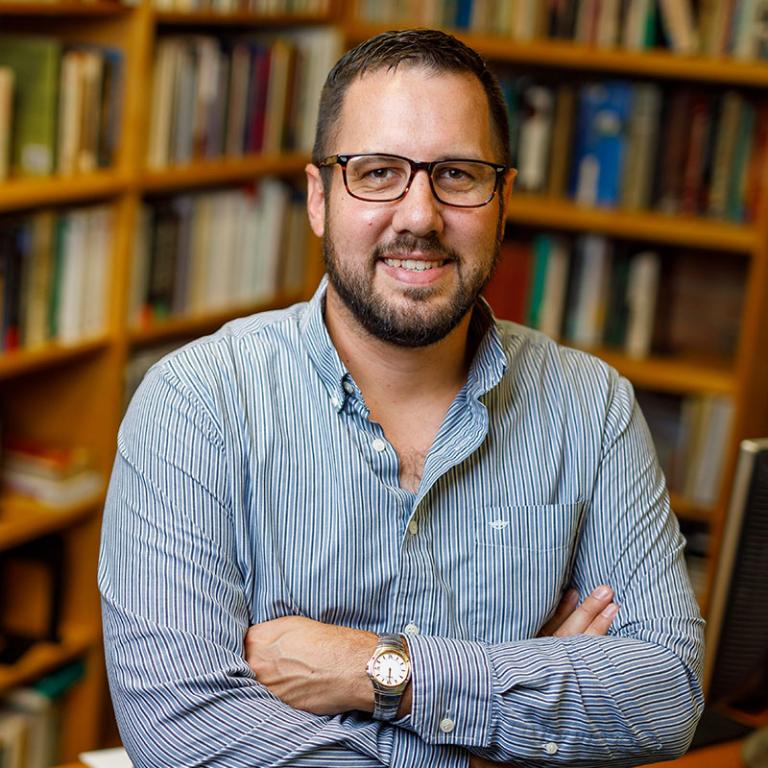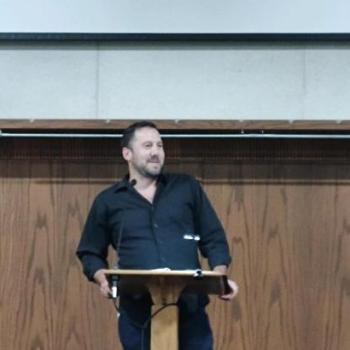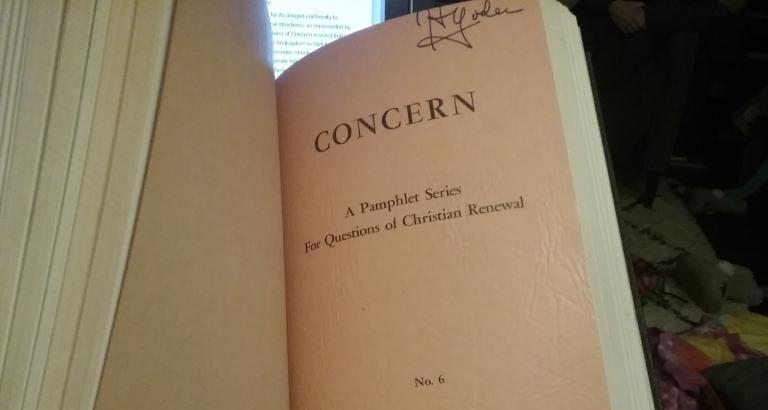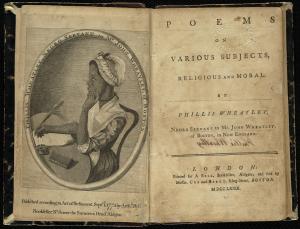Recently I had a conversation with an AMBS colleague about the distinction between Anabaptism and neo-Anabaptism. After I shared with him what I thought the differences were, I did what I normally do when I’ve just said something with more confidence than is warranted: I went back to my office and looked up the terms on the Global Anabaptist Mennonite Encyclopedia Online (GAMEO!).

Problem is, there’s no entry there for neo-Anabaptism (yet). And the original entry for Anabaptism is written in part by the father of neo-Anabaptism (or so I argue below), Harold Bender.
So I’ll have to settle for the next best option: blog about it and let the Mennosphere correct me if I’m wrong.
Here’s my take:
As I’ve written about previously, Mennonite historian Harold Bender’s 1944 essay “The Anabaptist Vision” set the agenda for Anabaptist theology in the second half of the 20th century by defining 16th-century Anabaptism in terms of three distinctive features: “first, a new conception of the essence of Christianity as discipleship; second, a new conception of the church as a brotherhood [sic]; and third, a new ethic of love and nonresistance.” This definition was predicated on the assumption that “true” or “normative” Anabaptism was the “evangelical Anabaptism” of the Swiss Brethren—the group who produced the Schleitheim Confession.
By the time Bender co-authored the Mennonite Encyclopedia article on “Anabaptism” in 1955, his co-author, Robert Friedmann, concluded: “The present analysis has been more negative than positive. It needs, therefore, ample supplementation. H. S. Bender’s Anabaptist Vision and his analysis of the church concept of the Brethren . . . might well supply it.” In other words, for Friedmann (and Bender), Anabaptism just is Bender’s vision of Christianity as discipleship, fellowship (“brotherhood”) of believers, and love and nonresistance.
As historical scholarship on Anabaptism progressed in the two decades following Bender and Friedmann’s article, a new understanding of Anabaptism took shape. As James M. Stayer, Werner O. Packull, and Klaus Deppermann argue in their 1975 article, “From Monogenesis to Polygenesis,” 16th-century Anabaptism has its roots not only in the Swiss Brethren but also, independently, in other distinct dissenting movements of the radical reformation. These developments in historical scholarship complicated Bender’s vision of Anabaptism by including historical Anabaptist leaders who differed from the Swiss Brethren mold such that, by the 1990 addition to the article on “Anabaptism,” Mennonite historian Walter Klaassen writes: “The word Anabaptism is normally used in the late 20th century to denote the mosaic of groupings of dissenters without at the same time making claims to uniformity. . . . Anabaptism was pluralistic.”
Based on the polygenesis definition, Anabaptism describes not a vision but a group (or groups) of people descending from groups of radical dissenters of the Reformation, including Mennonites, Hutterites, Brethren, and others.
However, contemporaneous with developments in the historical scholarship were developments in Anabaptist theology that took Bender’s vision as its starting point. The most significant of these was a young scholar named John H. Yoder who was trained as a Reformation historian but became better known as a theological ethicist through his publications. To the best of my knowledge and recollection, Yoder coined the term “neo-Anabaptism” in an essay in the Concern pamphlet series in the 1950s, though its use wasn’t popularized until much later. (And, no, I don’t recall the reference, though if someone does, I’d love to see it!) For Yoder, as for Bender, the Swiss Brethren and their Schleitheim Confession is theologically normative for Anabaptism, polygenesis notwithstanding.
If Anabaptism describes the groups of people descending from the radical Reformers, then neo-Anabaptism severs that historical lineage by “looping back” directly to the Swiss Brethren, drawing its vision from them, and trying to recover that vision in the 20th century. Although Yoder could be critical of his mentor Bender, he nevertheless latched onto Bender’s understanding of Anabaptism by describing the “original revolution” in terms of a vine that loops back on itself rather than a tree with branches that grow off a common trunk. And so, by the late twentieth century, what we get is a family tree of flesh-and-blood Anabaptists (Anabaptism) defined over and against a vine looping back on an earlier vision of radical Christianity (neo-Anabaptism).
Then in the late twentieth and early twenty-first century there came an interesting, though not entirely unsurprising, twist to the story. Yoder’s writings started to gain traction outside the Anabaptist world due in part to his Notre Dame colleague Stanley Hauerwas, a then-Methodist theological ethicist who became a pacifist by reading Yoder. Once Yoder’s writings took flight outside of the Anabaptist fold, a number of non-Anabaptists realized that they, too, were drawn to the vision of radical Christianity described by Yoder and Bender before him. If the Anabaptist vision just is radical discipleship, radical community, and radical love (exemplified by nonresistance or nonviolence), then one need not be an Anabaptist in order to be a neo-Anabaptist!
After a couple generations of neo-Anabaptism as a renewal movement within Anabaptism, then, neo-Anabaptism took on a distinct life of its own outside of Anabaptism. Today most of the names associated with neo-Anabaptism come from other ecclesial traditions: Stanley Hauerwas (Methodist turned Anglican), Scot McKnight (evangelical turned Anglican), David Fitch (C&MA), Greg Boyd (evangelical), and Shane Claiborne (evangelical turned new monastic).
Thus, while acknowledging some room for nuance, McKnight has written that Bender’s “Anabaptist Vision” just is Anabaptism, or at least “the most influential view of Anabaptism of the 20th Century.” Yet McKnight has also most recently written a full-throated defense of infant baptism, which again suggests that one need not be Anabaptist (literally, rebaptizer) to be neo-Anabaptist.
Now that neo-Anabaptism has been set from from its origins within Anabaptism, some neo-Anabaptists have returned to tell Anabaptists that they aren’t Anabaptist enough. Enter Greg Boyd, who explicitly distinguishes between “traditional Anabaptism” and “neo-Anabaptism.” Boyd writes of an “ever-increasing multitude of individuals and groups are being captivated by the same vision of God and his kingdom that captivated [him] around the turn of the century,” which in some ways “resembles . . . the Anabaptist stream,” but “in other fundamental respects . . . doesn’t look anything like traditional Anabaptism.”
For Boyd, what’s keeping “traditional Anabaptism” from better resembling his Anabaptist vision is that “outside of their missionary activity to non-western people groups, Anabaptists have for the most part remained ethnically and culturally homogeneous.” For Anabaptists to welcome neo-Anabaptists into their fold, then, Boyd posits that they will need to embrace three goals: (1) “to detach their identity, values and mission from their distinctive ethnicity and culture,” (2) “to let go of whatever vestiges remain of the isolationist mindset of traditional Anabaptism and to instead intentionally move outside their comfort zone to forge, cultivate and nurture relationships across ethnic and culture lines”; and (3) “to explore creative ways of connecting with [neo-Anabaptists] as they assume a learning posture in dialogue with them.”
On the one hand, Boyd is certainly right that Anabaptists still have a ways to go toward becoming a diverse, multicultural movement. On the other hand, there’s something deeply troubling about telling Anabaptists to detach themselves from their “distinctive culture” in order to attract neo-Anabaptists. For one thing, Anabaptism has exploded into a global movement within the last thirty years or so, and it’s done so by and large through the efforts of those “traditional Anabaptists” (and arguably a work of the Spirit). As the Institute for the Study of Global Anabaptism notes, “Today there are some 2.1 million Anabaptist-Mennonites in the world, representing 305 groups in 87 countries. From the perspective of five centuries of Anabaptist history, this is a phenomenal development that is transforming the character and future of the tradition.” And this explosion is taking place not only in the global South. Even within North America, Anabaptism is becoming increasingly urban and diverse, though it still has a long way to go. But its diversity has come not as a result of detaching from its culture and letting go its vestiges of traditional Anabaptism but by expanding its culture to welcome and include other cultures within it.
The irony is that neo-Anabaptism as such is the vision of white men (Bender, Yoder) that continues to be propagated in large part by white men (Hauerwas, McKnight, Fitch, Boyd, Claiborne). As a white man myself, I say that not as critique but as a simple acknowledgment of reality. What does become problematic, though, is when that white male vision is set over and against an admittedly imperfect tradition of flesh-and-blood Anabaptists who are trying to be a witness to a way of life in and through their cultural embeddedness. Of course the reality will never live up to the vision, but if the vision itself includes a fellowship (“brotherhood”) of believers as one of its three distinctive features, then it necessarily must be embedded and embodied in particular groups of people (Anabaptists?), despite their many imperfections. And over time those particular groups of people will necessarily develop a particular culture. Telling this group of people to detach their identity from their culture, then, is tantamount to telling them to erase their tradition in order to embrace a vision, which seems like a false dichotomy to me.
At the end of the day, Anabaptists may need neo-Anabaptists to continue holding their feet to the fire, but neo-Anabaptists also need Anabaptists to provide feet for the movement.












